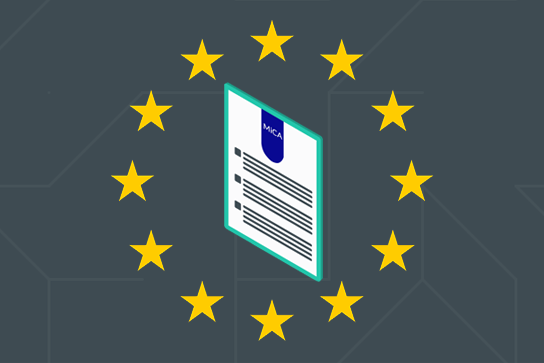
The Ultimate Guide to MiCA's Asset-referenced Tokens
This guide will dive into the Markets in Crypto-assets Regulation’s (MiCA) explanation of asset-referenced tokens (ARTs), providing helpful information to issuers and holders of ARTS along with what is expected of them to meet MiCA’s requirements.
An Overview of What CASPs Need to Know about ARTs
What Is an Asset-referenced Token?
According to REGULATION (EU) 2023/1114 OF THE EUROPEAN PARLIAMENT AND OF THE COUNCIL of 31 May 2023 on markets in crypto-assets, and amending Regulations (EU) No 1093/2010 and (EU) No 1095/2010 and Directives 2013/36/EU and (EU) 2019/1937, referred to as MiCA going forward, an ART is a crypto asset that pegs its value (or rights) to more than one fiat, physical asset, cryptocurrency, or a mixture of all three.
Risks Associated with Asset-referenced Tokens
ARTs may see a broader acceptance amongst holders for value transfer or exchange, heightening risks for safeguarding crypto-asset holders, especially retail investors, and market integrity, in contrast to other crypto assets. Consequently, issuers of these tokens should face stricter regulations than issuers of other crypto assets.
Monitoring and Supervision of Asset-referenced Tokens
To ensure the correct monitoring and supervision of ARTs, issuers must have an office registered in the European Union (EU). Additionally, public offerings of ARTs in the EU or applications for trading admission of such crypto assets should only be allowed if the competent authority has authorised the issuer and approved the corresponding crypto-asset white paper.
Although, this authorisation prerequisite does not apply if
The ARTs are exclusive to qualified investors, or
The public offering is below EUR 5 000 000.
However, the crypto white paper still needs to be produced to warn investors of the potential risks involved, and the competent authorities need to be notified before the ART is released to the public.
Authorised credit institutions (under Directive 2013/36/EU) do not need additional authorisation under MiCA to offer trading of ARTs.
If the jurisdiction’s competent authority suspects that issuing a specific ART threatens the market or the financial stability of payment systems, the applicable must be refused. Furthermore, the competent body must contact the EBA, ESMA, the ECB, and the jurisdiction's central bank if the issuer operates in a Member state that does not use the euro
Responsibilities of Retail Holders and Issuers of Asset-referenced Tokens
Retail holders and issuers are responsible for providing ART holders with complete, transparent information that is not misleading or unfair. Also, white papers must contain information on how the ART is stabilised - what it is pegged to, the reserve assets, custody arrangements for these assets and the holder’s rights.
This information needs to be provided regularly, and issuers need to provide the following information on its website:
How many ARTs are in circulation,
The value of the reserve and how the reserve is made up, and
Any events that could severely impact the valuation of the ARTs or reserves.
Moreover, retail holders and issuers must have a procedure for handling complaints and always act with integrity. There also needs to be a policy in place to manage any conflicts of interest.
A robust governance structure must be established, including clear organisational frameworks with transparent lines of responsibility. Its purpose is to identify, manage, monitor, and report risks. Management members must not have any convictions related to money laundering or terrorist financing. Shareholders or members with qualifying holdings must also be clear of any convictions.
Issuers should allocate resources proportionate to their activities, ensure continuity, and establish business continuity policies. They must maintain strong internal controls, effective risk management procedures and ensure the integrity and confidentiality of information. These measures aim to protect token holders, particularly retail investors, without unnecessarily hindering operations.
Reserve of Assets for Asset-referenced Tokens
Issuers of ARTs play a pivotal role in the network, facilitating the issuance, transfer, and distribution of these crypto-assets. They must establish contracts with third-party entities to manage stabilisation mechanisms, invest reserve assets, and custody them. They should also ensure the distribution of tokens to the public. To mitigate risks to financial stability, such issuers should adhere to fund requirements proportionate to token issuance size, calculated as a percentage of reserve assets. Competent authorities may adjust these requirements based on factors like risk management, asset volatility, and transaction volume settled in ARTs.
Issuers of ARTs must have and maintain a reserve of assets to cover the liability to token holders, for example, in cases of insolvency. The reserve's value should at least equal the value of tokens in circulation, and changes should be managed to prevent adverse impacts on reserve asset markets. Clear policies should detail the reserve's composition, asset allocation, risk assessment, token issuance and redemption procedures, and investment policies.
If marketed in both the EU and third countries, issuers must ensure the reserve covers liabilities to EU holders, with reserves held by firms subject to EU law in proportion to expected EU market share.
Segregation of Assets
To safeguard ARTs and maintain their value, issuers must implement an adequate custody policy for their reserve assets. This policy ensures full segregation of reserve assets from the issuer's assets, prevents encumbrance or pledging as collateral, and guarantees prompt access to these assets. Reserve assets may be held by a crypto-asset service provider (CASP), an authorised credit institution under Directive 2013/36/EU, or an investment firm under Directive 2014/65/EU, with the possibility of delegating custody to another entity for physical assets. Custodians are liable for reserve asset loss unless it results from an external event beyond their control.
Holders of ARTs have the right to redeem them at any time. The issuer must honour redemption requests by either paying an amount equivalent to the market value of the referenced assets or delivering the assets themselves. Holders should always be able to redeem funds other than electronic money, denominated in the same currency accepted during token sale. The issuer must provide clear and easily understandable information about redemption options.
Asset-referenced Tokens that Are Significant Have Increased Standards
For an ART to be considered “significant”, 3 of the following 5 criteria need to be met:
The size of the issuer or providers’ customer base,
The total value of the tokens issued,
The number of daily transactions,
The value of daily transactions, or
The issuer’s token offering is available in over 7 EU member states.
Once deemed significant, ART issuance will be supervised under an increased set of standards by the EBA. Arts deemed significant may be used by numerous holders, posing particular challenges related to financial stability, monetary policy transmission, or monetary sovereignty. Therefore, significant ARTs should adhere to stricter regulations than those considered less significant. Specifically, issuers of significant ARTs should meet heightened capital requirements, adhere to interoperability standards, and establish a comprehensive liquidity management policy.
The Monitoring of Asset-referenced Tokens
A comprehensive monitoring system for issuers of ARTs is crucial to assess their size and impact. This monitoring encompasses all transactions related to these tokens, whether settled on or off the distributed ledger, including transactions between clients of the same crypto-asset service provider.
Transactions settled with ARTs as a means of exchange within a single currency area, excluding those associated with investment functions, should be considered. If ARTs are widely used to exchange within a single currency area, issuers may be required to reduce activity. Central banks should have the authority to intervene if these tokens threaten payment system operations, monetary policy transmission, or monetary sovereignty, including withdrawal of authorisation or imposing limits on issuance.
Issuers must prepare recovery plans to restore compliance with reserve asset requirements, and competent authorities can suspend token redemption temporarily if necessary for financial stability. Issuers should also have plans for orderly token redemption in case of non-compliance or discontinuation.
When issuers are credit institutions or entities under Directive 2014/59/EU, resolution authorities should be consulted, with the power to assess redemption plans' impact on issuer resolvability and make recommendations to competent authorities. This examination should not impede the prudential supervisory or resolution authority from taking crisis prevention or management measures.
Find out more about the European Union’s Travel Rule requirements - speak to one of our experts.



